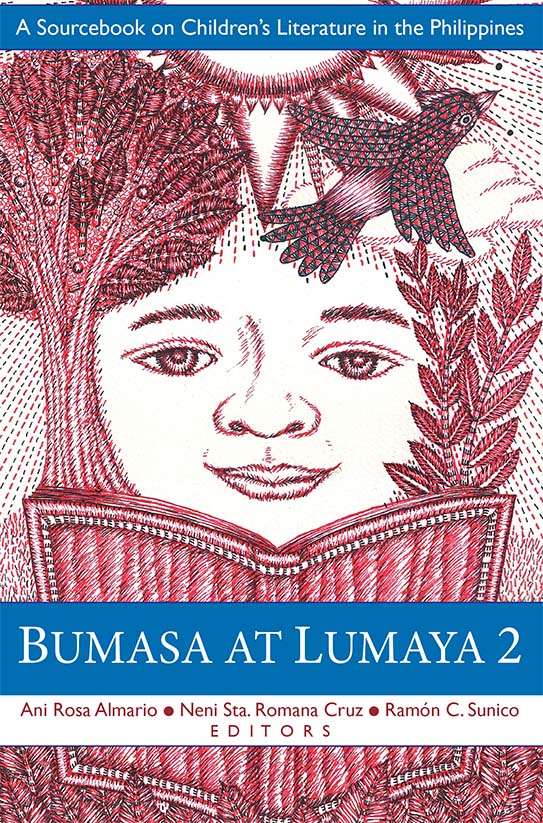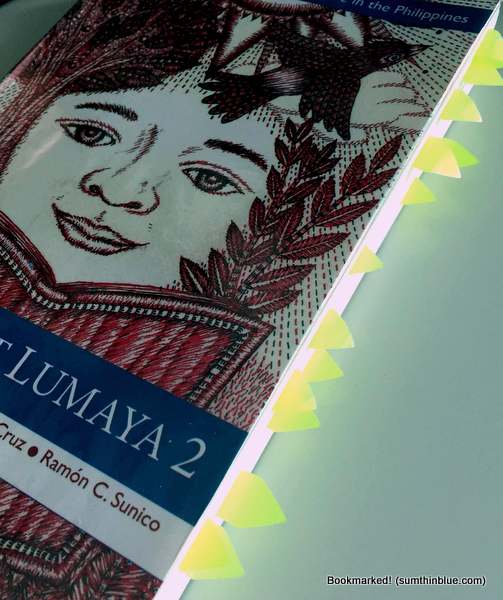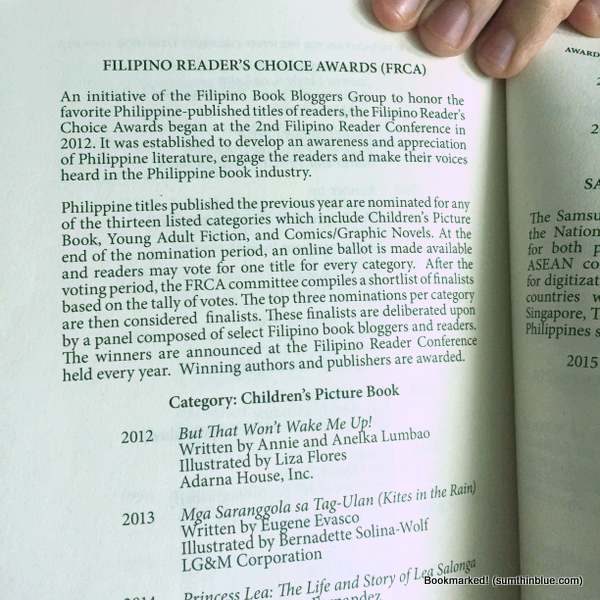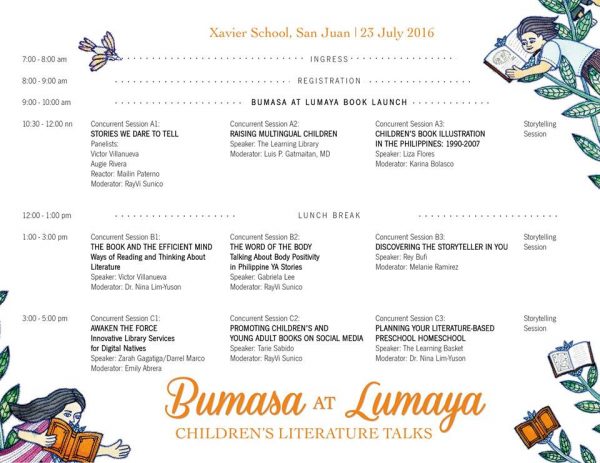
In celebration of the 33rd National Children’s Book Day, I received a review copy of the second edition of “Bumasa at Lumaya 2: A Sourcebook on Children’s Literature in the Philippines,” edited by Ani Rosa Almario, Neni Sta. Romana Cruz, and Ramon C. Sunico.
I encountered the first “Bumasa at Lumaya” (1994) book in college while I was doing research for my thesis, which was about the process of creating a children’s book. The Rizal Library had a copy of the book, and while I appreciated the context it provided me of the Philippine children’s book industry, the year was 2005 and I had to rely mainly on articles I could find online for more recent articles I could use as reference.
This second volume comes as a much needed update on the first, an essential sourcebook for students, teachers, writers, illustrators and other children’s content creators, publishers, and generally anyone who is involved or interested in Philippine children’s books.

The book is a collection of essays, articles, talks and interviews, transcripts of forums and roundtable discussions about children’s literature in the Philippines, written by (or featuring) writers, illustrators, bookmakers, readers and educators.
The late, great Rene O. Villanueva’s poem, “Kay Sarap Magbasa,” makes an inspiring start to the book, and Eugene Evasco gives an overview of children’s literature in the Philippines between 2000-2013.
This is followed by quite a number of resources for writers: Rene O. Villanueva delves into the psyche of the young reader, the prevalence of myths and legends in children’s literature, and how to retell these stories for the young reader. Neni Sta. Romana Cruz’s interview then Rene O. Villanueva gives us a peek into his emergence as a children’s writer, his process, and recommendations both for fellow or aspiring children’s writers as well as the industry on the whole.
Lara Saguisag’s essay on poetry raises a valid point: “It seems to me that our curriculum is filled with poetry that may not speak to Filipino children” and recommends the next step: “to produce more poems that engage our Filipino children.
I also quite enjoyed Christine Bellen’s “Ang Muling Pagsasalaysay ng Mga Kuwento ni Lola Basyang,” because having illustrated one of the books in the series, it was interesting to find out how the stories were retold and written for a more contemporary audience.
“Writers Speak” is possibly my favorite section of the book, because it was composed largely of dialogue – it felt like I was in the room with the respondents and I thoroughly enjoyed the responses that were both candid and enriching.
“The Bookmaker’s Art” is also an excellent resource for illustrators, with Ruben de Jesus’ analysis of visual directions in Filipino children’s books spanning over three decades; Liza Flores’ reportage of the children’s book illustration industry, covering the rise of the Filipino illustrator as a co-creator of a book, the evolution of styles and tools, the process by which publishers select and compensate illustrators, and other useful information local illustrators wont’ find elsewhere. Paolo Chikiamco’s “crash course in comics appreciation” makes a great primer for the uninitiated, with helpful book recommendations that teachers, parents, and readers can start with.
I was also quite happy to see the Filipino Readers’ Choice Awards as part of the awards listed in the appendix – a validation of something we at the Filipino ReaderCon have worked so hard for in the past five years, and it does us proud for the award to be acknowledged in this book.

But…
While this book is definitely a landmark work for the Philippine children’s book industry, there are several things worth pointing out.
First, while the materials in this book are recent, not everything is current or up to date, most noticeably Evasco’s overview, which stops at 2013; and Carla Pacis and Ramon Sunico’s essay on YA Literature in the Philippines. I think the last three years have been among the best for both children’s and young adult literature in the country, and these two selections in particular could have used the update. I’m not saying the information they presented aren’t relevant, but because these two selections are somewhat dated, there are definitely some gaps — nothing on e-book technology, the emergence of early reader books, novelty books, child-oriented magazines and other publications, and the sheer growth in titles of comics, graphic novels and YA lit — I’m sorry, I just don’t think the conclusion that YA content in the Philippines is “losing steam” applies anymore.
Second, in as much as the industry acknowledges the other stakeholders in the creation and appreciation of children’s books (and of course, a book can only have so many pages, the book is still largely writer-centric — nearly half the book is dedicated to writers and writing of children’s literature in the Philippines. And there are so many other perspectives to consider.
For instance, illustration and comics are lumped together in one section of this book when there is so much more to be said for both. I’d also have appreciated a selection on translation, one of the most important aspects of children’s literature that has seen landmark developments in recent time. Booksellers and marketers also have an interesting perspective to offer, in the trends in the local book industry and what sells. Storytellers, who transform words and photos into another art form. And what about developers of e-books, apps, reading kits, and other formats for today’s readers – I believe perspectives from other content creators can contribute a lot more to the ongoing discussion. (That said, I also think the terminology “children’s literature” is largely outdated; we should move towards the direction the region – and the world is going – and look at children’s content as a whole instead of literature in isolation, as today’s kids are “reading” (or consuming) and learning in many different ways and formats unique to their generation.
The “reader” section is somewhat of a misnomer, presenting literacy initiatives and an essential guide to starting a library but absolutely nothing from a reader’s perspective. Where are the discussions with children and teens about books they’d like to read or stories they want written and illustrated, or what makes them buy a book? Where are the YA fan girls who storm the book fair halls for a glimpse of their favorite Wattpad author? Where are the die-hard comics readers who flock to each Komikon for the latest volumes of their favorite creators? Where are the book clubs, the reviewers? This section was a bit of a letdown for me, a missed opportunity in presenting the point of view of a very important stakeholder, the consumer of the work this industry works so hard for (and now you know why readers feel disenfranchised).
Finally, I find the one entry under “Book Reading and Learning” by reading education advocates highly limited (though the two previous articles under “The Reader’s Part” would have done better under this section, I believe), as the educators themselves acknowledge that developing literacy should go beyond the classroom walls. A counterpart entry that covers non-traditional or informal reading programs would have been a good counterpoint.
(N.B. Don’t get me started on the “We [Filipinos] are not a reading culture” or any permutations of the “Filipinos don’t read” claims. Disproving this claim is exactly what we stand for in voluntarily organizing the Filipino ReaderCon and the Filipino Readers’ Choice Awards every year – we refuse to accept it, and we can show you why.)
All that said (and I apologize for going on at length), this book is still an invaluable resource for the industry, and I have no doubt putting this book together was quite an undertaking for all those involved. I do hope this won’t be the last of its kind in documenting the continued growth of the industry as well as the ongoing dialogue with the stakeholders. I agree with the general premise of the book, that while there is much work to be done, the industry has come a long way. Children’s books and YA are among the fastest-moving books off the local selection, with a considerable number of new titles each year, denoting that there is no lack of concern nor effort for the development of children’s content, and definitely no lack of talent.
***
Bumasa at Lumaya 2, review copy, 4/5 stars
This post is part of the Bumasa at Lumaya Blog Tour.

***
P.S. The NCBD2016 Book Fair and Children’s Literature Talks will be held on Saturday, July 23 at the Xavier School in San Juan. Will be hanging out at the Ang INK Booth — see you there!


Yehey! Great post, Blooey. May mga kulang pa rin nga sa book. :D
Sana may Part 3! :)